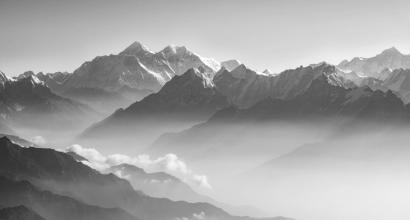A similar example can be seen even in business : (1) Adhiṣṭhāna = Capital and site of business (2) Kartā: the businessman’s and his knack (3) Karaṇa: the stock and instruments of measuring weights and lengths (4) Ceṣtāḥ - advertising and other means of attracting buyers (5) Daiva - customers liking a product or otherwise.
Thus, effort is in the domain of humans; the decision on the results is in the divine domain. Since this is how the facts stand, the instruction is that humans should not worry about the result. There are two concepts here:
- Results belong to the daiva, not to humans. It is a futile strain for him to think about them.
- By giving up thought of the results, it becomes an opportunity for his egotism and selfishness to erode. There is thought about the results when there is ego. When there is no ego, karma is performed only because it is a duty.
Daiva
Daiva is the hidden energy that is the basis of the entire order of the universe. It is the supreme controlling energy of the universe that decides the state and progress of beings.
There are many happenings in the world that are beyond our cause-and-effect analysis. Our intellect suffers without understanding the relationship between these phenomena. Such phenomena are commonly called daiva, perchance, coincidence, serendipity, adṛṣṭa, etc.
If we do not know the origin or cause of some incident, we call it ’ākasmika’ (a+kasmāt). If the cause and effect of something is not visible to us, we call it ‘adṛṣṭa’ (unseen). If the causes of an effect are hidden, it is from daiva.
Among the effects of Īśvara that are seen in this world, some are mūrta (with form) and some are amūrta (without form). Mūrta are those that are tangible — having a perceptible body. Among the five elements, ākāśa is intangible, earth, water and tejas are tangible. Air and ākāśa do not have any bodily form. Just like ākāśa, there are uncountable intangible powers in Īśvara. Since they are intangible, humans cannot perceive them. We cannot say that something does not exist just because it is not perceived. There is something called ākāśa. Its existence and activity are not visible to our eyes. However, it can be discerned by sound, which is the effect of its presence. Without ākāśa, there is no work for our ears. There are thousands and thousands of natural faculties that work without our senses perceiving them. They are all part of daivī energy, or the secret of daiva.
***
Bhagavān has given us two assurances:
- Protection of the universe, establishment of dharma.
- Protection of bhaktas.
paritrāṇāya sādhūnāṃ vināśāya ca duṣkṛtāṃ ।
dharma-saṃsthāpanārthāya sambhavāmi yuge yuge ॥-BG 4.8
yogakṣemaṃ vahāmyaham ॥
-BG 9.22
na me bhaktaḥ praṇaśyati ॥
-BG 9.31
Establishment of dharma is for the protection of the universe. Kindness and mercy are for the protection of bhaktas. This is different from the universal order. The universal order is a rule - rigidity, regularity. Mercy is a relaxation of these rules. Man begs for so many things, and does so many things. Seen from the perspective of the order of the universe, those requests must not be granted to him; his deeds are not right. If results are only based on universal order, his desires cannot be fulfilled. On the other hand, his doings may be punished. However, Bhagavān is merciful. If he is generous, he can give what he wants; he can wipe out human mistakes with his mercy. Thus, compassion and affection different from the universal order become available to a bhakta. This is daiva.
***
It can be said that there are two energy centers that decide the state and passage of a man :
- Universal Prakṛti
- Gained from the past
Prakṛti is a manifestation of the five elements. Among its works, some follow a fixed order and can be observed by us: rising of the sun and moon, change of seasons, a seed sprouting, a dog giving birth to a dog and not a cat, fire cooking rice, etc., There are many among the works of Prakṛti that are not apprehended by known rules: storm, flood, drought, earthquake, pestilence, etc. These are daivī.
Among the results of puṇya and pāpa acquired by the jīva over many lives from the beginning of time, there is still some remaining for the jīva to experience. That is prārabdha-karma. No one can fathom its nature or form, but all of us experience its good and bad results. This is also the impact of daiva.
When the energies of the prakṛti supply the appropriate results of hidden karma of a jīva in mysterious ways, it is called daiva.
The jīva’s ability to perform karma is a part of the energies of the universal prakṛti. Therefore, daiva is the secret strategy of universal prakṛti.
The circle of the universe is subservient to Īśvara. Īśvara decides how the universe should be run, how it should be protected, what should be provided to which jīva and so on.
ahaṃ sarvasya prabhavo mattaḥ sarvaṃ pravartate ॥
-BG 10.8
***
Īśvara’s energy is limitless. We can discern four streams originating from that boundless ocean of energy :
- Viśva-prakṛti (Nature)
- Human effort and adventure, human exertion
- The results of past karma of the jīva
- Incarnation of Bhagavān
Even if these streams are in full flow, the ocean can never dry up. It is always complete.
pūrṇasya pūrṇamādāya pūrṇam-evāvaśiṣyate ॥
-Śānti mantra, Īśāvāsyopaniṣat
Therefore, the flow of energy in the above four streams will never dry up, but will keep renewing itself. From this infinite ocean of energy flows a continuous stream into the channels of the universe. Daiva is the energy of Īśvara flowing in the third of the above channels that feeds the results of karma or akarma to the jīva. Daiva is the authority of Īśvara that subordinates man’s effort and exertion, without considering his likes or dislikes, to aid a great plan of the universe. The karma of an individual and the order of the collective universe are both the fields of work of daiva.
Yajña and its fruit
The goodness of prakṛti is the reply to man’s goodness.
(4) Bestowing objects of desire
labhate ca tataḥ kāmān mayaiva vihitān hi tān ॥
-BG 7.22
The world believes that Bhagavān fulfils the desires of his bhaktas, and gives them boons that they ask for. When does he do that? How does he grant them?
There are many people who have begged the divine profusely and have been disappointed. There are people who have performed vratas, pūjās, service, and other religious observances and yet haven’t seen any boon. Probably, such people are the majority in the world. What about them?
That Īśvara is the bestower of desires is a statement that shows the predominance of bhakti. What is the principle here?
The affirmations of Bhagavān are two:
- Protection of the universe, and the establishment of dharma for that.
- Protecting bhaktas while not hampering the protection of the universe.
Thus, there are two limits for fulfilling the desires of bhaktas.
- The order of prakṛti
- The dictates of past karmas of the jīva.
Both of these are parts of ṛta. Ṛta itself is satya — truth. Dharma is the active manifestation of truth. This is the principle. Therefore, whenever our desires are unopposed to the order of the universe and the order prescribed by our past karmas, then they are endorsed by dharma. What is endorsed by dharma is approved by the divine.
There is another thing here that is more relevant here. The wholesome benefit (hita) to a bhakta is more important than his iṣṭa (desire). A sick person’s iṣṭa comprise pakoras[1] and sweets; whereas pepper and ginger are hita. A doctor knows what is good and bad for the body; Bhagavān knows what is beneficial or otherwise for a jīva. Therefore, if a bhakta in a hasty fit of desire prays for the grant of his wishes, it is Bhagavān’s greatness that considers the propriety and impropriety of the devotee’s cravings, and only grants what is hita (beneficial) for him. Bhagavān knows the haste of his devotee as well as the state of his jīva. Therefore, Īśvara’s office is to understand and bestow the right boon that aids in the progress of the devotee at the right time, in adherence to the order of prakṛti and his past karmas, without going against the laws that protect the universe.
To be continued...
The present series is a modern English translation of DVG’s Kendra Sahitya Akademi Award-winning work, Bhagavad-gītā-tātparya or Jīvana-dharma-yoga. The translators wish to express their thanks to Śatāvadhāni R Ganesh for his valuable feedback and to Hari Ravikumar for his astute edits.
Footnotes
[1]A kind of savory made of gram flour.











































